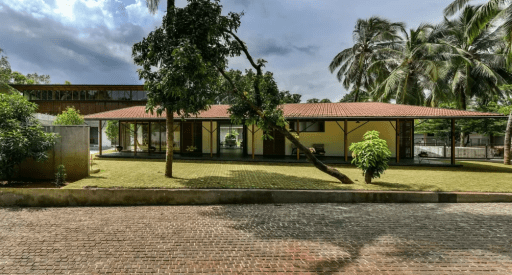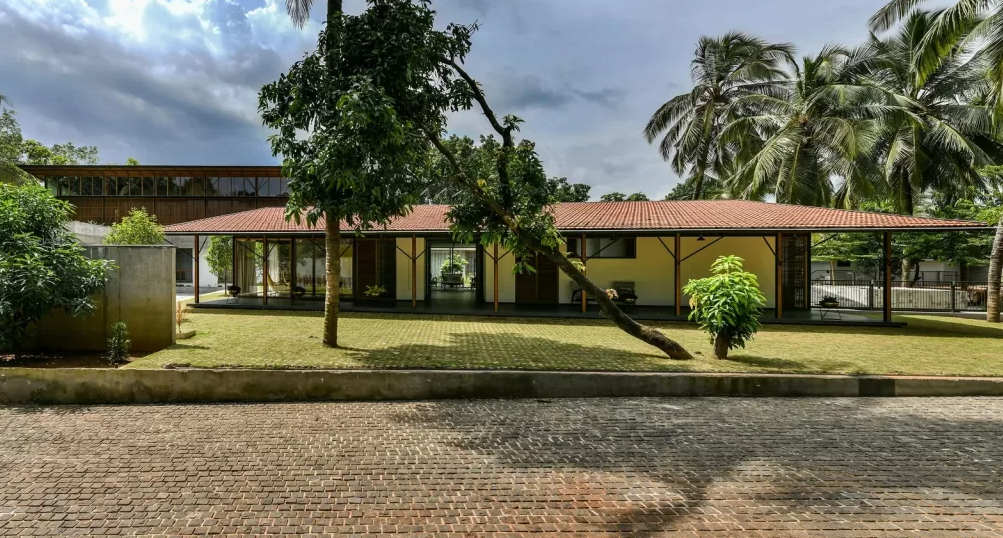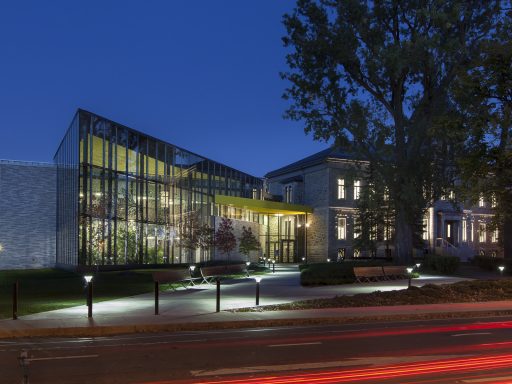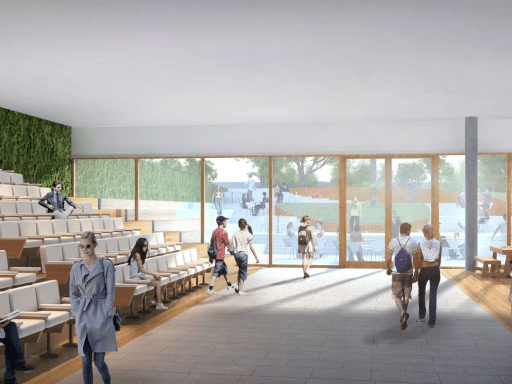What is Tropical Modernism?
Tropical modern architecture is an architectural style that emerged in the mid-20th century, combining the clean, minimal lines of modernist architecture with the climate-responsive design elements necessary for tropical environments. It focuses on creating spaces that blend seamlessly with their natural surroundings while adapting to the challenges of high humidity, intense sunlight, and heavy rainfall typical in tropical regions. This unique fusion of aesthetics and function emphasizes sustainability, natural ventilation, and the integration of outdoor and indoor spaces.
1. Introduction to Tropical Modernism
Tropical modernism is a distinct architectural movement that harmonizes modernist design principles with the needs and conditions of tropical climates. It evolved to suit the hot and humid climate of regions like West Africa and South Asia. It represents an architectural approach that considers the natural environment as an essential part of the design process. Born from the modernist tradition that emphasized function, simplicity, and new materials, tropical modernism incorporates these values while adapting to the unique challenges posed by the tropical weather, such as high temperatures, heavy rains, and intense humidity.
This design philosophy prioritizes openness, natural light, and passive cooling strategies, using local materials and drawing on the surrounding landscape to create spaces that are both functional and aesthetically pleasing.
2. Historical Context
The origins of tropical modernism date back to the mid-20th century when modernist architecture began to spread globally. As architects in tropical regions began to embrace the modernist style, they quickly realized that adaptations were needed to suit the local climate. Pioneers of tropical modernism combined the sleek, geometric forms of modernist buildings with design principles that allowed for better airflow, shading, and integration with nature.
In countries like Sri Lanka, Brazil, and India, architects like Geoffrey Bawa, Oscar Niemeyer, and Charles Correa introduced this new style, which would later spread across other tropical regions. These architects found innovative ways to merge the aesthetics of modernism with the practicalities of tropical living.
The Victoria and Albert Museum in London currently features an exhibition titled ‘Tropical Modernism: Architecture and Independence’. This exhibition at the Albert Museum highlights the influence of Tropical Modernism on postcolonial architecture in India and Ghana. It showcases how architects from these regions adapted modernist design principles to reflect local cultural motifs and practices, emphasizing the historical significance of Tropical Modernism in the architectural narrative of postcolonial nation-building.
3. Regional Variations in Tropical Modernism
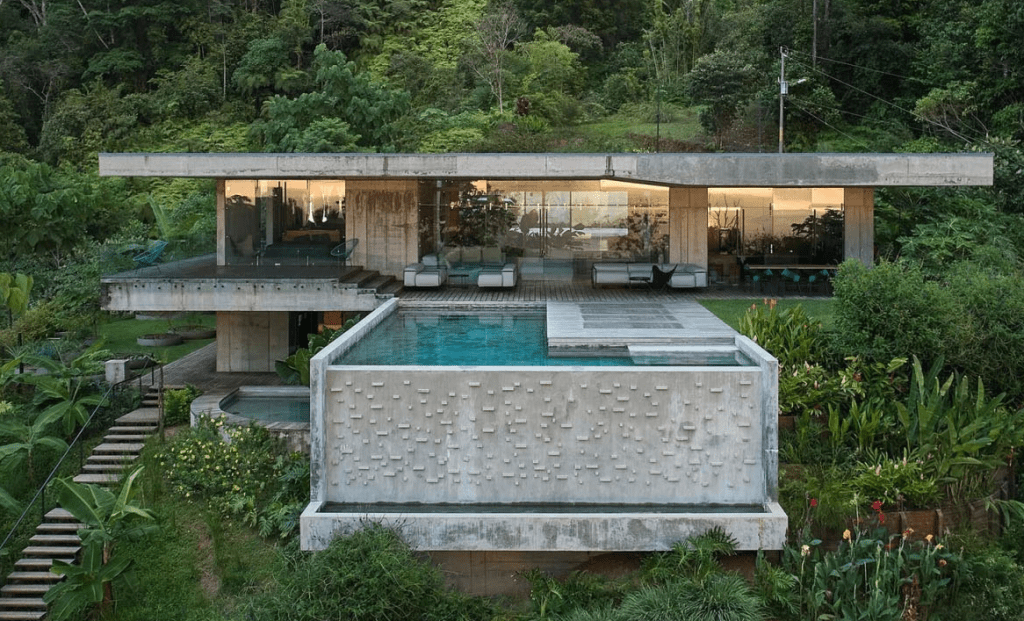
Tropical Modernism has manifested differently across various regions, reflecting the unique cultural, political, and environmental conditions of each area. In West Africa, the movement was intertwined with political power and national identity. Post-independence leaders like Kwame Nkrumah saw the potential of Tropical Modernism to symbolize progress and unity. In Ghana, for instance, Nkrumah commissioned both Ghanaian and African American architects to construct public projects that would reflect the nation’s new identity.
In Latin America and Southeast Asia, Tropical Modernism evolved to reflect distinct vernacular traditions and modernization agendas. In Brazil, architects like Oscar Niemeyer incorporated local materials and forms to create buildings that were both modern and deeply rooted in the local context. Similarly, in Southeast Asia, architects adapted modernist principles to suit the tropical climate, using wide overhangs, open ventilation, and local materials.
In India, the influence of Tropical Modernism can be seen in the work of architects like Balkrishna Doshi and Achyut Kanvinde. They implemented Le Corbusier’s planned city of Chandigarh and established a school of architectural design that focused on a syncretic, distinctly Indian practice and vision. Their work reflects a blend of modernist design principles with traditional Indian architectural elements, creating buildings that are both functional and culturally resonant.
How is Tropical Modern Architecture Different from Modernism?
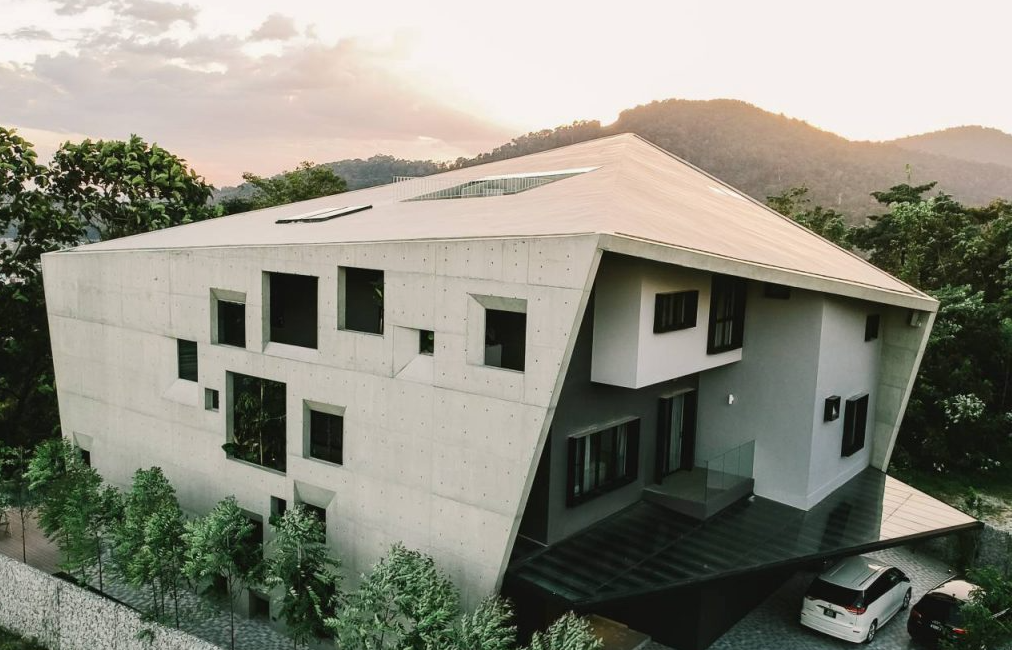
While both tropical modernism and modern architecture share a foundation in clean lines, minimalism, and functionality, tropical modernism diverges in several key ways to accommodate the distinct environmental, cultural, and climatic challenges of tropical regions. Below is a comprehensive comparison of the two architectural styles, highlighting their differences in design principles, materials, climate responsiveness, and overall philosophy.
1. Climate-Responsive Design vs. Universal Functionality
- Modernism: Traditional modernism, which emerged in the early 20th century, was driven by the idea of creating universal spaces that prioritized functionality and the rejection of ornamentation. Modernist architects like Le Corbusier and Mies van der Rohe emphasized open floor plans, geometric forms, and industrial materials like steel, glass, and concrete. Modernism is often more concerned with abstract design principles, without necessarily adapting to the specific climate or context in which a building is situated.
- Tropical Modernism: In contrast, tropical modernism tailors its designs specifically to climate-responsive needs. This architectural style is deeply influenced by the local environment and focuses on creating structures that can withstand the heat, humidity, and heavy rains typical of tropical regions. Key features such as wide overhangs, open ventilation, and passive cooling techniques are essential in tropical modernism. Tropical architecture, a key component of this style, incorporates sun shading, cross ventilation, and the use of local materials to create functional, aesthetically pleasing buildings that harmonize with their environment. While modernism might prioritize form and function, tropical modernism goes further by integrating local climatic conditions into every aspect of the design.
Material Use: Industrial vs. Local Building Traditions
- Modernism: Modernist architects championed the use of industrial materials like concrete, glass, and steel. These materials were valued for their sleek, minimalist look and structural capabilities. In modernist design, there was often a focus on creating buildings that could be reproduced at scale, with little regard for local materials or environmental considerations.
- Tropical Modernism: Tropical modernism takes a more sustainable and locally-focused approach. While concrete is still commonly used, tropical modernist architects often incorporate natural materials such as wood, bamboo, and stone, which are better suited for humid and hot climates. These materials not only complement the natural surroundings but also help with ventilation and temperature control, making buildings cooler and more comfortable. Additionally, tropical modernism prioritizes sustainability by using locally sourced materials, reducing the environmental impact of construction. Local building traditions also play a significant role, influencing the choice of materials and integrating vernacular elements like pitched roofs and wide eaves into modern designs.
3. Integration with Nature vs. Separation from Environment
Modernism: Modernist buildings often stand apart from their natural surroundings, with clean, rigid lines and geometric forms. While modernism doesn’t completely reject nature, it typically sees the building as an independent object, with its surroundings often being treated as a backdrop rather than an integral part of the design.
Tropical Modernism: One of the most defining features of tropical modernism is its integration with nature. Architects practicing this style design buildings that blend seamlessly with the natural landscape. Courtyards, gardens, and water features are commonly incorporated into the architectural design, creating a close relationship between the indoor and outdoor spaces. Tropical Modernism draws inspiration from indigenous architecture, emphasizing the cultural significance and climate-responsive techniques of local building traditions. In tropical modernism, the environment is not just considered but celebrated, with the architecture often being shaped by the landscape, trees, and water around it.
Ventilation and Cooling Strategies in Tropical Climate: Passive vs. Active
- Modernism: Modernist buildings often rely on artificial heating and cooling systems to create comfortable indoor environments. The universal design approach of modernism didn’t take regional climate into account, meaning that many modernist buildings required significant air conditioning or heating, depending on their location.
- Tropical Modernism: In tropical modernism, passive cooling is one of the key strategies. Buildings are designed to maximize natural ventilation, often featuring open plans, high ceilings, and large windows or doors that allow air to flow freely. Shade is another crucial element in tropical modernism, with wide overhangs, verandas, and balconies helping to reduce direct sunlight and keep interiors cool. Tropical modernist buildings also use water features and courtyards to create a cooling effect, which is particularly important in regions where high temperatures and humidity are the norm.
5. Criticism and Colonial Legacy
Tropical Modernism has faced criticism for its colonial roots, particularly in regions such as West Africa. The design principles of Tropical Modernism were initially tailored to cater to the comfort of colonial administrators, fostering a notion of a more productive colonial subject to counter calls for independence. This has led to a perception that the style was complicit in colonial exploitation.
However, post-independence leaders like Kwame Nkrumah recognized the potential of Tropical Modernism for nation-building, intertwining it with Pan-African ideologies to foster a sense of national identity and progress. In Ghana, Nkrumah established the Kwame Nkrumah University of Science and Technology to educate a new generation of architects locally, with many campus buildings designed by John Owusu Addo, a Ghanaian architect.
In India, the adoption of Tropical Modernism was influenced by the colonial legacy of the movement. Prime Minister Jawaharlal Nehru recruited British architects Maxwell Fry and Jane Drew to design the new Punjab capital at Chandigarh, which became India’s first large-scale modernist project. This collaboration highlighted the complex interplay between colonial influence and the desire for a modern, independent identity.
3. Key Architects and Pioneers
One of the most notable figures in tropical modernism is Sri Lankan architect Geoffrey Bawa, whose work in the 1960s and 1970s remains a benchmark for the movement. Bawa’s designs are characterized by a seamless blend of indoor and outdoor spaces, creating homes, hotels, and public buildings that interact harmoniously with the environment. Bawa’s iconic “Kandalama Hotel” is an exemplary model of tropical modernism, where the architecture seems to grow organically out of the landscape.
Brazil’s Oscar Niemeyer, known for his work on the futuristic capital city of Brasília, also incorporated elements of tropical modernism in some of his buildings, focusing on large, open spaces and the use of curves to evoke a sense of fluidity with nature.
Charles Correa, an Indian architect, adapted modernist design to the Indian climate, emphasizing features like verandas, courtyards, and terraces to deal with heat while reflecting cultural and social elements in his work. Local architects played a crucial role in the development of Tropical Modernism, incorporating culturally relevant and sustainable solutions that reflect the identity and needs of their communities.
4. Defining Principles of Tropical Modernism
At its core, tropical modernism, often referred to as ‘tropical modern’, is defined by several key principles:
- Climate Adaptation: Designs that respond to local climate conditions, particularly tropical heat and humidity.
- Integration with Nature: Buildings that are in harmony with the natural landscape, incorporating elements like courtyards, terraces, and water features.
- Simplicity and Functionality: Like traditional modernism, tropical modern embraces minimalism, avoiding excessive ornamentation.
- Sustainability: Use of sustainable materials and building techniques that reduce environmental impact and enhance natural cooling.
These principles make tropical modernism highly functional and eco-friendly while maintaining a timeless aesthetic.
5. Climate-Responsive Design in Tropical Modernism
A defining feature of tropical modernism is its climate-responsive design. This involves employing architectural strategies that mitigate the challenges of living in a tropical climate. Passive cooling techniques are central to this approach, where the design of the building reduces the need for artificial cooling systems like air conditioning.
For instance, many tropical modernist buildings feature large overhangs, shaded verandas, and louvers that block direct sunlight while allowing air to flow through the spaces. Natural ventilation is a key strategy, as high ceilings, open-plan layouts, and wide openings like doors and windows encourage air circulation and reduce indoor temperatures.
The use of materials that can handle humidity and rainfall is also vital. Concrete, for example, is commonly used for its durability and cooling properties.
6. The Use of Natural Light and Open Spaces
Tropical modernism prioritizes the use of natural light and open spaces to create bright, airy interiors that connect seamlessly with the outside. Large windows, glass walls, and open layouts allow for an abundance of natural light to flood indoor spaces. This helps reduce the reliance on artificial lighting, making buildings more energy-efficient.
Open-plan designs are another hallmark of tropical modernism. These spaces not only encourage ventilation but also foster a stronger connection with the surrounding landscape. Architects often use courtyards and terraces to blur the lines between indoor and outdoor living, creating a sense of unity between the home and its environment.
Integration of Nature into Indigenous Architecture
The integration of nature is one of the most captivating aspects of tropical modernism. Unlike many architectural styles that separate buildings from their environment, tropical modernism seeks to incorporate nature into the design. This can be achieved in several ways, such as:
- Landscaping with local plants: Greenery is often a central feature in tropical modernist buildings, with native plants being used to enhance the natural beauty and ecological balance of the site.
- Water features: Ponds, pools, and streams are often included in tropical modernist designs, providing a cooling effect and enhancing the tranquil ambiance.
- Indoor gardens: Some tropical modernist homes and buildings incorporate indoor gardens or planters to bring nature into the interior spaces.
This seamless integration creates a holistic environment where architecture and nature coexist harmoniously.
8. Sustainable and Eco-Friendly Design
Tropical modernism places a strong emphasis on sustainability. From the early days of the movement, architects have sought to use materials that are locally sourced and environmentally friendly. This not only supports local economies but also reduces the carbon footprint associated with transporting building materials.
Sustainability in tropical modernism also extends to energy efficiency. By relying on natural ventilation, passive cooling, and natural lighting, tropical modernist buildings minimize their energy consumption, which is particularly important in regions where the climate requires significant cooling efforts.
12. How Tropical Modernism Works in Practice
Tropical Modernism works in practice by incorporating local materials, passive cooling techniques, and the incorporation of local symbols and motifs. The style is designed to regulate the internal climate of buildings, using techniques such as natural ventilation, shading, and water features to mitigate the harsh tropical climate. Buildings designed in this style are typically oriented to maximize natural ventilation and minimize solar heat gain, thereby reducing the reliance on mechanical cooling systems.
The use of local materials is a hallmark of Tropical Modernism, reflecting a commitment to sustainability and a respect for local traditions. Materials such as timber, stone, and thatch are commonly used, often in innovative ways that reflect both modernist and traditional craftsmanship. The indoor-outdoor connection is also a key feature of Tropical Modernism, with large openings, verandas, courtyards, and other transitional spaces encouraging the flow of air and the extension of living spaces into the landscape.
13. Tropical Modernism in the 21st Century
Tropical Modernism continues to influence contemporary architectural practices, especially in the quest for sustainable design solutions in tropical climates. The style has evolved to incorporate new materials and technologies, while maintaining its commitment to local traditions and environmental responsiveness. In the 21st century, Tropical Modernism has become a model for sustainable and climate-resilient design, with many architects around the world drawing inspiration from its principles and practices.
The Victoria and Albert Museum’s exhibition “Tropical Modernism: Architecture and Independence” explores the history and significance of the style, highlighting its role in shaping the built environment of tropical regions. The exhibition features works by British architects Maxwell Fry and Jane Drew, as well as Indian architects such as Balkrishna Doshi and Achyut Kanvinde, and Ghanaian architects such as John Owusu Addo.
14. Case Studies and Examples
Several case studies and examples illustrate the principles and practices of Tropical Modernism. The Centre for Environment Planning and Technology in India, designed by Indian architect Balkrishna Doshi, is a notable example of Tropical Modernism in practice. The building features a blend of modernist design principles and local architectural traditions, with a focus on natural ventilation, shading, and water features.
Another example is the Black Star Square in Accra, Ghana, designed by Ghanaian architect Victor Adegbite. The building features a large, open plaza surrounded by modernist buildings, with a focus on natural ventilation, shading, and local materials. The building has become a symbol of Ghanaian independence and national identity, reflecting the country’s commitment to modernity and progress.
These case studies and examples demonstrate the enduring relevance of Tropical Modernism, highlighting its potential to shape the built environment of tropical regions in sustainable and climate-resilient ways.

